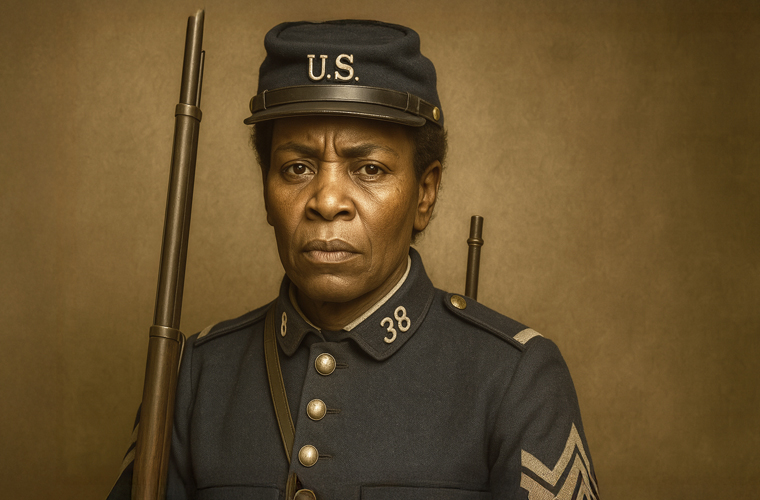Cathay Williams was born in September 1844 in Independence, Missouri, to an enslaved mother and a free father, which legally rendered her a slave. During her adolescence, she worked as a house slave on the Johnson plantation near Jefferson City, Missouri. In 1861, at the onset of the Civil War, Union forces occupied Jefferson City, and Williams, then 17, was declared “contraband.” She was pressed into service as a cook and washerwoman for the Union Army, traveling with the 8th Indiana Volunteer Infantry Regiment under Colonel William Plummer Benton. Her travels took her through Arkansas, Louisiana, and Georgia, where she witnessed significant events like the Battle of Pea Ridge and the Red River Campaign. She later served briefly under General Philip Sheridan in the Shenandoah Valley campaign in 1864.
After the Civil War ended in 1865, job opportunities for freed African Americans, especially women, were scarce. Motivated by a desire for independence, Williams made a bold decision. On November 15, 1866, she disguised herself as a man and enlisted in the U.S. Army under the pseudonym William Cathay (sometimes spelled Cathey due to her illiteracy). She joined Company A of the 38th U.S. Infantry Regiment, one of the newly formed all-Black units later known as the Buffalo Soldiers. Only her cousin and a close friend, both fellow soldiers, knew her true identity. Williams passed a cursory medical examination, which did not reveal her gender, and was deemed fit for duty. Stationed initially at Jefferson Barracks outside St. Louis, she later served at Fort Cummings and Fort Bayard in the New Mexico Territory. As a Buffalo Soldier, she performed garrison duties, including marching, guard duty, and scouting missions, often with inadequate supplies and inferior weapons, conditions typical for Black soldiers in remote western outposts.
Her military career was challenging. Shortly after enlisting, Williams contracted smallpox and was hospitalized. She rejoined her unit in New Mexico, but frequent hospitalizations followed, possibly due to the lingering effects of smallpox, the harsh New Mexico climate, or the physical toll of years of marching. Remarkably, her gender remained undetected during these medical visits until October 1868, when a post surgeon at Fort Bayard discovered she was a woman. She was honorably discharged by her commanding officer, Captain Charles E. Clarke, on October 14, 1868, on a certificate of disability. After her discharge, Williams resumed her identity as a woman and worked as a cook at Fort Union, New Mexico, before moving to Pueblo, Colorado. She later settled in Trinidad, Colorado, where she worked as a seamstress and possibly ran a boarding house. In 1876, her story gained public attention when a St. Louis Daily Times reporter interviewed her, publishing an article titled “She Fought Nobly” on January 2, 1876. This was the first public account of her military service.
In late 1889 or early 1890, Williams was hospitalized in Trinidad for over a year, suffering from neuralgia and diabetes, which led to the amputation of all her toes. In June 1891, she applied for a disability pension based on her military service, citing precedent from women like Deborah Sampson who received pensions for Revolutionary War service. However, her claim was denied in February 1892, with the Pension Bureau citing insufficient evidence of a pensionable disability, though her service as William Cathay was not questioned. It is believed she died shortly after this denial, around 1893, though her exact date of death remains unknown.
Cathay Williams’ story is one of resilience and defiance against the constraints of race, gender, and societal norms. As the first documented African American woman to serve in the U.S. Army and the only known female Buffalo Soldier, she broke barriers in a time when both women and African Americans faced severe discrimination. Her decision to enlist was driven by a practical need for financial independence, as she stated, “I wanted to make my living and not be dependent on relations or friends.”
Her legacy has been increasingly recognized. In 2016, a bronze bust was unveiled at the Richard Allen Cultural Center & Museum in Leavenworth, Kansas, and in 2018, a monument bench was dedicated to her on the Walk of Honor at the National Infantry Museum in Columbus, Georgia. Williams’ story challenges historical narratives about who could be a soldier and highlights the ingenuity and courage of a woman who navigated systemic barriers to carve out a place for herself. While she may not have sought to be a trailblazer, her service as Private William Cathay remains a powerful testament to her determination and a significant chapter in American military history.

